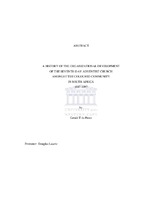| dc.description.abstract | The Seventh-day Adventist Church in South Africa was planted towards the end of the 19th century. Within less than forty years after its inception, a separate Coloured department developed. This was not to be the last organizational development impacting upon the Coloured community within the Church. The problem that this study will seek to address is:“What factors contributed to the different organizational phases that the predominantly ‘coloured’ section of the Seventh-day Adventist Church in South Africa underwent between 1887 and 1997?” It will examine particularly the role and impact of racism on the various organizational phases.METHOD: The study was conducted primarily within the qualitative paradigm. This paradigm was selected as it allowed the researcher to analyse, interpret and understand events in history and the present in terms of the experience and definition of the world as experienced by others.As a qualitative study, the research utilised the approach in which a literature study was conducted involving current literature and archival material on the subject. With regard to the
archival material, extensive use was made of primary sources, specifically utilising the minutes of the different organizational structures. The researcher was able to source a large amount of material dating back to the turn of the 20th century. These materials were systematically scrutinised in order to discover any material of relevance to the topic being researched.CONCLUSION: The study has demonstrated that racism has been an all-pervasive factor within South Africa
since the time of the invasion of the country by European colonists. Commencing with the Dutch in 1652, the fabric of the social and political structure became inextricably linked to a hierarchy which placed the White Europeans in authority over the indigenous inhabitants of this country by virtue of being the conqueror backed by superior weapons of war and control of the economy and the means of production.Legislation was enacted, firstly by the Dutch and subsequently by the British to protect the interests of the invaders and systematically disenfranchise the inhabitants of South Africa. The indigenous inhabitants of the country and their descendents were relegated to being 2nd and 3rd class citizens of their country in order to feed the greed and expansionist agenda of the European invaders. This social structure impacted upon and influenced every aspect of South African existence.The Seventh-day Adventist Church did not engage society on its view and position regarding human relations and racial discrimination. It uncritically merged its thinking and operations to reflect the majority view of the minority ruling class. This it did despite the biblical view of the Church on the nature and equality of man, its historical heritage and the counsel as given by Ellen White.
While some commentators have postulated that the Church was ahead of the government in applying Apartheid, it appears as though it would be more accurate to state the Church uncritically imbibed and adopted the policies of the government of the day. As has been seen,while the practice of segregation and separation became subsumed in the ideology of Apartheid as propagated by the post-1948 Nationalist government, the discrimination practiced by the Church found its roots in the social engineering initiated by Van Riebeeck and perpetuated by successive governors, prime ministers and other heads of state to varying degrees.From the turn of the 20th century the Church pursued an agenda of separation culminating in
formal organizational structures for the different racial groupings as instituted by the Dutch,British and subsequent South African governments.Each phase of the organizational development of the Seventh-day Adventist Church in South
Africa, as applied to the Coloured community, can be seen to having been influenced by and impacted upon by the Church’s view and practice of separation based on colour. No evidence can be found in the documentation available that the creation of separate structures for different racial groups in South Africa was for any other reasons than racial separation. | en_US |

